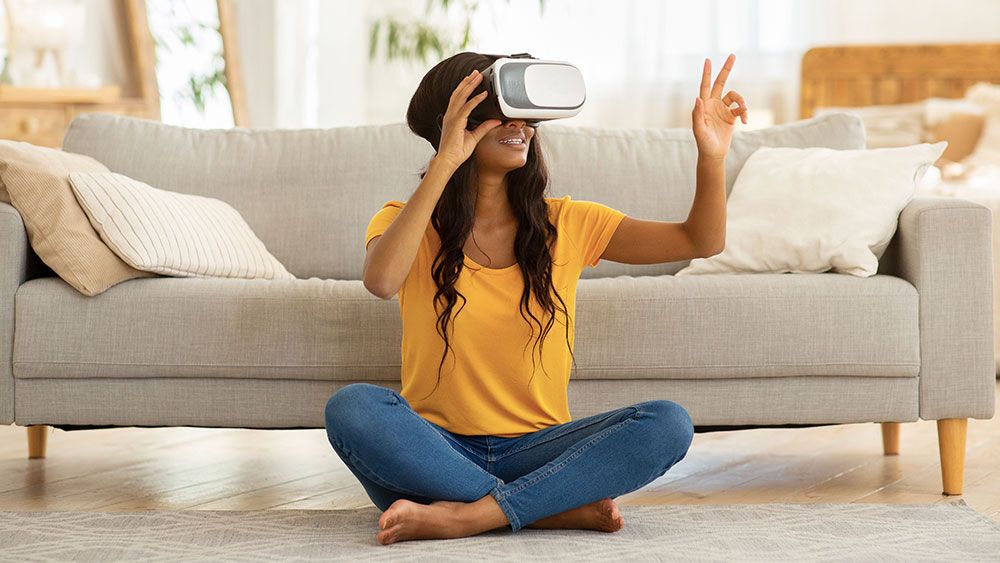Imagine walking through a house you’re interested in buying. You scoot around the furniture and glide through different rooms. You can imagine yourself preparing large meals for the holidays in the kitchen, working diligently in the home office, and tucking the kids in bed at night. Just when you’ve seen enough to make a decision, you take off the virtual reality headset and you’re back in your current home.
This is the future of home selling: virtual reality. VR can sell homes across time and space, aiding home buyers in envisioning their life in a new space without actually being there. The benefits of virtual tours and virtual staging are still being realized. Brunswick Crossing takes a look at the intricacies of virtual reality in home selling.
What is VR home staging?
The benefits of staging a home that’s ready to go up for sale are well known. Staged homes close 86% faster. Instead of an empty shell, potential buyers walk through a house that is furnished and decorated to help them visualize living there. Home sellers can stage a house themselves or they can hire a professional company to bring in furniture and design the space. However, with the continued effects of the pandemic and the advancement in technology, home sellers don’t need to spend thousands of dollars decorating rooms with physical furniture. And, home buyers don’t even need to leave the comfort of their home to tour a house.
Virtual reality can be utilized by home sellers in two ways: virtually staging an empty home and giving tours via 360 video that can be loaded into a virtual reality headset. In action, virtual staging allows home sellers to render furniture and decor onto images of their empty rooms. As for virtual tours, the possibilities are still being explored. At a base level, virtual tours provide 360 views of a space while clicking through different rooms of a house. These can be loaded in a headset for a more immersive experience and may or may not include virtual staging furniture. Beyond that, a virtual reality tour could be even more immersive. A home buyer can tour a home wearing a VR headset while a realtor remotely guides them. They can even change aspects of the home to suit the buyer’s interests, such as kitchen counters. We won’t even get into augmented reality, which would allow prospective buyers to view a space even before it’s built.
How does it work?
When it comes to using virtual reality to sell your home, it’s all in the equipment and software. Depending on what you’re trying to achieve, all you may need is a camera that takes high quality photos. A more immersive experience may require 360 and other specialized cameras. There are companies that create interactive experiences for home buyers. For example, Studio 216 offers photography, animation, virtual tours, and more. There are also numerous apps for those looking to build an immersive experience.
What are the pros?
As the technology that enables virtual reality experiences progresses, the benefits of virtual staging and tours become more and more enticing. The main benefits include cost, convenience, and creativity. While staging a home generates major ROI--586%--it can be exceedingly expensive to do. According to Home Advisor, the national average cost to stage a home is $1,261, but it could cost anywhere between $523 and $2,005. On the flip side, virtual staging could cost as little as $15 per photo from Visual Stager. Services like RoOomy offer $49 per photo or $725 for a 3D virtual staged tour of a 1,651 to 2,050 sq.ft. house. Or, you can spend between $350 to $700 for a virtual reality video.
Virtual reality tours allow home buyers to experience a house without leaving the comfort of their home. They can tour or view a space on their own schedule without the hassle of traveling or scheduling an appointment. And, in the days of COVID, it means safety. Lastly, virtual reality allows room for more creativity. Experts can change features such as wall colors, decor, furniture, and even the weather outside in ways that some in person could not.
What are the cons?
While virtual reality in home selling poses many benefits, there are also drawbacks to consider. One includes accessibility. VR headsets are still a developing technology and lack widespread adoption. Staged photographs can also be misleading and transparency is key. Lastly, prospective buyers who want to visit the home in person may expect to see it staged only to find it a hollow shell when they arrive at the location.
How to prepare your home?
If you’re considering virtually staging your home either for photography or virtual reality tours, here are some ways to prepare. Clean and empty your home so that the designer doesn’t have to. Complete home improvement projects such as touching up the paint or polishing the floors. Look out the windows at what the camera might pick up outside. Lastly, take high quality photos or videos that will make the final product look sharp. This may mean hiring a professional.
While preparing to sell your home, envision your new life in a Brunswick Crossing home. Check out our available models and view virtual tours below:




